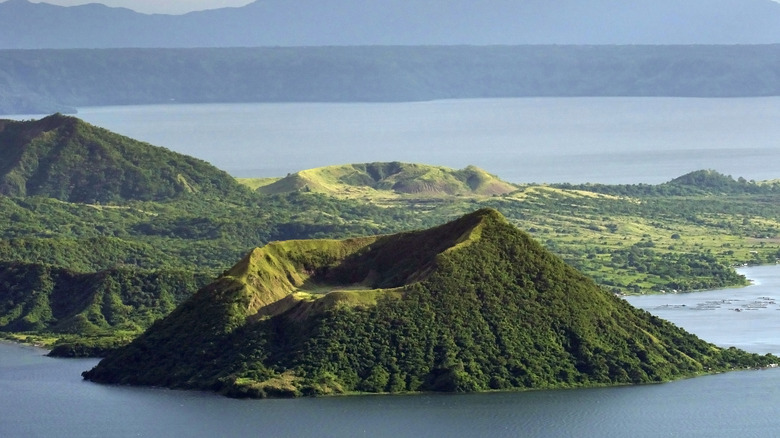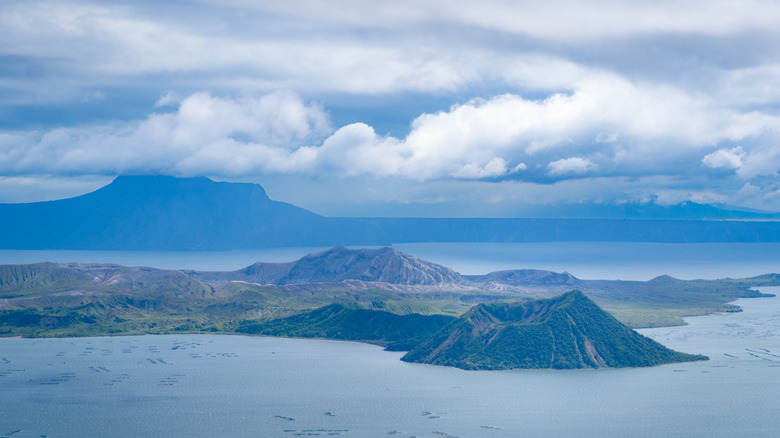Are Volcano Eruptions In The Philippines A Threat To Tourists? Here's What You Need To Know
The video opens mere moments after the initial blast: A towering plume of smoke in all shades of grey rises from a green, flat-top mountain above a quiet lake, punching through low clouds before cascading down in thick sheets of ash that resemble a woolly mammoth's head. The camera stays steady as the person filming jumps into a small boat and speeds away, holding the shot while the mushroom cloud swells. Other small boats scatter across the water. Off-screen, the person holding the camera and the boat's driver verbally react in real time to what looks like a scene straight from "Terminator 2" or "Oppenheimer." Eventually, it seems the boat will get to safety, and nothing more explosive happens — just slow-moving ash swelling and settling. This eruption, it turns out, was captured at the deadly Taal Volcano in Batangas Province, Philippines, on October 26, 2025, about 40 miles south of Manila. Taal is part of an active volcanic system and has remained a "permanent danger zone" since a major eruption in 2020, which underscored the risks of volcano tourism, as evidenced in the now-viral TikTok video.
@isaiasbesmontemab91 #Taal Phreatomagmatic Eruption 10/26/2025
According to the Philippine Institute of Volcanology and Seismology (PHIVOLCS), three minor eruptions and nine volcanic earthquakes occurred at Taal within 24 hours– including phreatomagmatic eruptions, when magma interacts with water and explodes into steam and ash — and phreatic eruptions, when underground water is heated by lava, magma, or "new volcanic deposits." Earthquakes followed, continuing a pattern of near-daily tremors throughout October, a stark increase from September's tally. Though PHIVOLCS assured the public that Taal's short-lived activity was fairly normal, an Alert Level 1 was maintained, and the Department of the Interior and Local Government mandated local readiness in case of further volcanic activity.
Taal is a geological phenomenon
The region's seismic activity is carefully monitored, and PHIVOLCS emphasizes that the eruptions are related to the volcano's hydrothermal system, not a fresh surge of magma. Philippine Airlines, the country's flagship carrier, has said it's avoiding flight paths near Taal, but has not disrupted its service due to eruptions.
Taal volcano is an island within a freshwater lake, which is itself on an island surrounded by a lake, in a rare geological pattern Atlas Obscura described as "something like nesting dolls." Vulcan Point is technically one of Taal Volcano's cones and is situated within Main Crater Lake — the largest crater lake in the world — which is on Volcano Island, which is surrounded by Taal Lake, all located on the island of Luzon in the Philippine archipelago. The area's part of the Ring of Fire, or Circum-Pacific Belt, a regional path through the Pacific Ocean where the majority of Earth's active volcanoes and major earthquakes occur.
Until the 2020 eruption forced mass evacuations, spread toxins, and claimed nearly 40 lives, the island had been inhabited and frequently visited by tourists for up-close experiences. Metro Manila, where Makati, the so-called "selfie capital of the world," is located, is only about 2 hours away. Although it's now strictly prohibited to live on or visit Taal Volcano, visitors can still get a safe view by taking a boat tour around the lake. You cannot hike it the way you can at Mount Pinatubo, but you can hire a boat or just enjoy distant views from nearby Talisay, or from elevated, scenic viewpoints in Tagaytay City, a popular day-trip destination from Manila.

